Exploring the Cultural Significance of Engagement Ring Placement

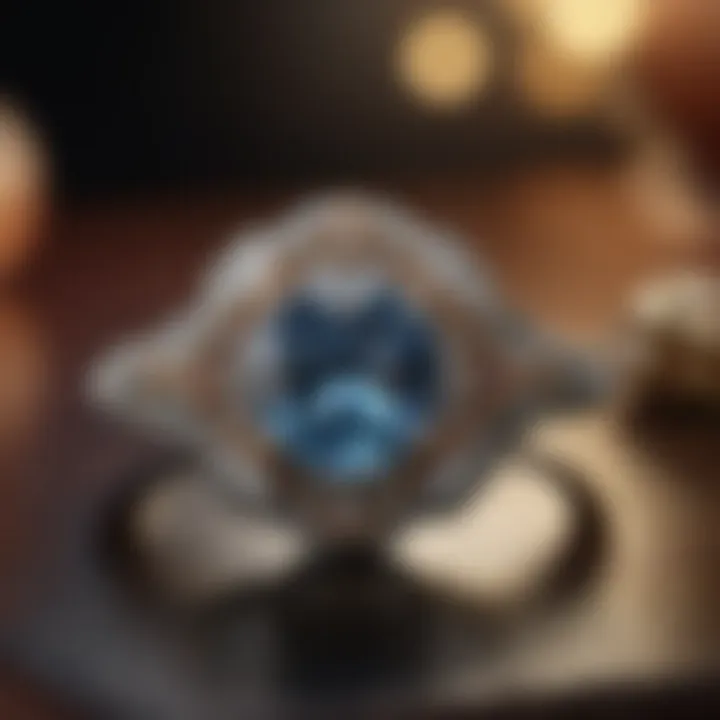
Intro
Engagement rings are more than just a piece of jewelry; they are steeped in rich cultural significance and historical narratives that transcend borders. The placement of these rings serves as a powerful symbol of commitment, making it imperative to understand the various practices that dictate their location on the hand. Different cultures have distinct traditions surrounding engagement rings, carving out spaces where meanings associated with love and partnership intertwine with social expectations and historical evolution.
In this exploration, we shall examine the intricate web of rituals surrounding the placement of engagement rings, unearthing the symbolic meanings behind why certain hands are chosen over others. We will journey through the ages, taking a close look at how these customs have evolved and adapted, giving rise to modern interpretations and personal choices. Let’s roll up our sleeves and dive into the significant depths of this fascinating subject.
Cultural Significance of Engagement Rings
The engagement ring often embodies more than just a piece of jewelry; it serves as a powerful symbol of love, commitment, and cultural heritage. Across various civilizations, the ring's placement can hold profound meaning, reflecting the values and traditions of the society it comes from. When exploring the significance of engagement rings, one finds multiple layers of meaning that intertwine individual sentiment with broader cultural narratives.
Historical Context
Engagement rings trace their origins back to ancient times. In ancient Rome, for instance, they were seen as a symbol of a man's vow to his partner, marked by a simple iron ring. The tradition evolved when gold became the material of choice, representing affluence and stability. Over the centuries, these rings have shifted in design and meaning, molding to fit the zeitgeist of their respective eras.
In more recent history, the 20th century witnessed the rise of diamonds as the predominant choice for engagement rings. This change was significantly influenced by marketing campaigns, most notably from De Beers in the 1940s, which firmly established the notion that "A diamond is forever." This statement not only elevated the diamond's status but also embedded it within the cultural fabric of engagement rituals.
Symbolism Behind the Ring
The engagement ring holds nuanced symbolism that varies by culture. It often signifies a promise and commitment, a circular form reflecting eternity with no end, much like love. The specific choice of materials—be it the clarity of a diamond, the colors of sapphires, or even the rich hues of a ruby—also plays a crucial role in conveying personal messages from the giver to the recipient.
Here are some elements of the symbolism behind the engagement ring:
- Love and Commitment: Represents an unbroken commitment, a visible sign of devotion.
- Family and Tradition: Often passed down through generations, it acts as a connection to family history.
- Personal Reflection: Choices made around design and stone selection often reflect the individual's character and aesthetic preferences.
"The true beauty of an engagement ring is not solely in its physical form, but in the stories, promises, and traditions it encompasses."
Traditional Placement in Different Cultures
The placement of engagement rings varies significantly across cultures, highlighting a rich tapestry of traditions and meanings. Understanding these practices invites us to appreciate love’s universal language while also recognizing the subtleties that different societies attribute to this simple piece of jewelry. This exploration elucidates how the act of wearing an engagement ring is steeped in both ritual and personal significance, providing insights into how people express their commitment in their local contexts.
Western Practices
In Western cultures, the left hand is often seen as the default choice for wearing an engagement ring. This tradition stems from the belief that the left hand has a direct vein leading to the heart, often dubbed the "vena amoris" or the vein of love. Here, the ring represents not just a promise of marriage, but a deep emotional bond between partners. It's common for couples to choose diamond rings, as the gem symbolizes eternity and strength, complementing the notion of everlasting love.
- Expectation and Norm: In addition to the romantic symbolism, wearing a ring on the left hand has become a societal expectation. Couples feel the pressure to conform to these standards, leading them to select rings that align with traditional aesthetics. The diamond engagement ring thus becomes not just a token of affection but also a signal to the world about one's relationship status.
- Cultural Variations: However, some individuals diverge from the norm. There are those who opt for unique designs, colored gemstones, or even choose to wear the ring on the right hand. This act of personal expression serves as a counterbalance to the conventional views prevalent in society.
Eastern Traditions
Engagement ring practices in Eastern cultures can differ markedly from the Western norm. For example, in countries like India, engagement rings are frequently exchanged during a pre-wedding ceremony called "sangeet." Here, family and friends gather, and jewelry, including engagement rings, is often gifted to signify acceptance into the family.
- Material Significance: In these cultures, the choice of metal and stone can hold significant weight. Gold, often seen as a symbol of prosperity, is frequently favored. The ring itself may also be intricately designed, serving as a reflection of cultural heritage.
- Symbol of Unity: The engagement process often encapsulates a deeper communal significance, representing family alliances rather than just romantic commitments. Thus, the placement and design of the engagement ring are imbued with greater importance in these settings, acting as a bridge between families.
Middle Eastern Customs
The Middle East presents a fascinating blend of tradition and modernity in its engagement ring customs. Here, the engagement ring is viewed not only as a sign of love but also as a binding contract between two families. Often, the groom is expected to present a substantial piece of jewelry, which showcases his financial stability and dedication to the union.
- Cultural Symbols: While diamonds are popular, other gemstones like rubies and emeralds are also cherished for their richness and beauty. The significance placed on these stones can be traced back to regional histories and preferences, where certain gems symbolize wealth and power.
- Ritualistic Aspects: Similar to many cultures, public displays are common in Middle Eastern engagements. Weddings are lavishly celebrated, and the ring serves as a focal point of intercultural showcasing, representing love but also societal status. The significance of the ring extends beyond the couple; it's a family affair, deeply rooted in shared customs.
Overall, the diverse traditions surrounding the engagement ring highlight not only the varying significances of love and commitment but also the social contexts they inhabit. As we continue to explore the ways in which personal preferences and cultural practices interweave, we’ll gain a broader understanding of why the placement of engagement rings continues to evolve in today’s world.
Contemporary Trends
The landscape of engagement ring placement has seen a significant shift in recent years, aligning more closely with modern values and individual tastes. In an era where personal expression often takes precedence, understanding contemporary trends in engagement ring placement is essential for those looking to navigate this intricate territory. It sheds light on how societal influences, preferences, and technology intertwine to redefine traditions. Key elements such as eco-conscious choices, customization, and the growing acceptance of alternative gemstones emerge as vital considerations.
Changing Preferences
Today's couples no longer feel constrained by conventional ring placements. This movement towards individualism reflects a broader cultural desire for authenticity. Many now choose different fingers or even forego the ring entirely, opting for personal symbols of commitment that resonate more profoundly with their relationships. For instance, some individuals now prefer wearing engagement rings on the right hand, which can symbolize balance and fairness in partnerships, or sometimes a personal struggle. Couples are reclaiming power over their engagement symbols, making choices that reflect their unique narratives rather than adhering to traditional norms.
"Ultimately, the engagement ring is less about its physical attributes and more about the stories it tells about the couple’s values and choices."
Moreover, alongside traditional diamonds, various gemstones are gaining favor. Hawaii's rare blue sapphires and Canada’s ethically sourced stones highlight a broader trend whereby couples prioritize sustainability and origin over merely following brand names. In addition to aesthetics, personal preferences increasingly dictate selections, influencing everything from style to carat size. This transformation illustrates a significant break from rigid expectations, allowing couples to craft their personalization statement.
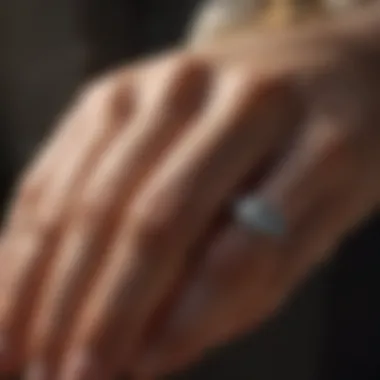
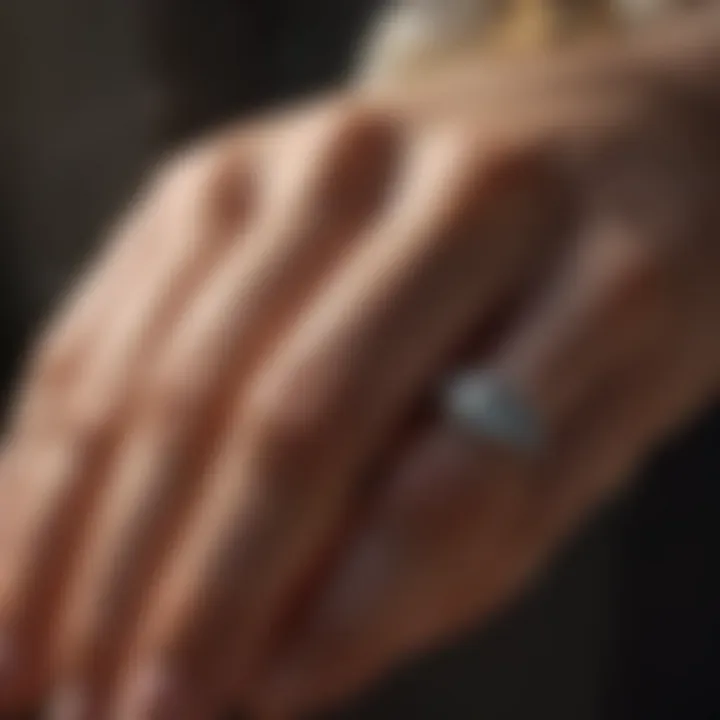
Influence of Social Media
It’s impossible to discuss engagement ring trends without acknowledging the role of social media. Platforms like Instagram or Pinterest have democratized inspiration for individuals worldwide. No longer confined to jewelry stores or family advice, prospective brides and grooms now seek inspiration from various sources, allowing them to explore myriad options from vintage heirlooms to contemporary designs.
Through hashtags and shared experiences, social media encourages a vibrant dialogue around ring placement and choices. The visual aesthetics featured on these platforms can quickly influence upcoming trends, such as the rising popularity of vintage and heirloom rings. Couples are not just looking at rings; they’re looking for a story that resonates with them. Photographers and influencers showcase unique placements, prompting new generations to consider unconventional ways of displaying their commitment.
In summary, contemporary trends in engagement ring placement embody a cultural shift that values identity and expression. As personal stories take center stage, the dialogue surrounding engagement rings is expanding, inviting more thoughtful choices and diverse placements than ever before.
As we move further into the 21st century, it becomes clear that the narratives surrounding engagement rings are as multifaceted as the stones themselves, driven by evolving societal norms and technology-driven influences.
Psychological Perspectives on Engagement
Understanding the psychology behind engagement rings and their placement delves into the intricate dance between society's expectations and individuals' sentiments. This examination is crucial to grasping how stories woven into these circles of metal and gem influence relationships and personal identity. Engagement rings carry more than just aesthetic appeal; they signify deep emotional ties and aspirations. It’s essential to explore both the societal implications and the personal narratives shaped by these symbols of commitment.
The Ring as a Status Symbol
Engagement rings are often viewed through the prism of social standing and financial capability. A notable portion of individuals associate the size, quality, and cost of a ring with the love and commitment from their partner. This reflects a societal belief that the value of a ring equates to the respect and attention one gives to the relationship. This mindset can bring from various places:
- Financial Investment: A ring, particularly one adorned with precious stones like diamonds, is often perceived as a significant financial outlay. Buyers view the act of purchasing a luxury item as a symbol of their dedication.
- Social Pressure: Friends, family, and societal norms can place expectations on individuals concerning what is deemed an 'appropriate' engagement ring, thus elevating its status.
- Personal Identity: For many, owning a beautiful ring becomes part of their identity. It can enhance a sense of belonging, both socially and within the relationship. This is doubly important in communities where status and wealth are closely linked to tangible representations.
However, the pursuit of a ring as a status symbol can also come with its share of pitfalls. Couples may find themselves struggling with expectations versus reality, leading to unnecessary financial strain or even feelings of inadequacy if the perceived status is not met. It's worthwhile to reflect on whether the significance of a ring should stem from its monetary value rather than its personal meaning.
"The true value of a ring lies not in its glitter or price tag, but in the story it tells and the bond it represents."
Emotional Significance
An engagement ring often serves as an emotional anchor, signifying promises, dreams, and future aspirations. The act of giving and receiving an engagement ring is laced with layers of meaning, including:
- Commitment: Beyond its physical presence, the ring embodies a promise of fidelity and partnership. It is a tangible reminder that both individuals are embarking on a shared journey.
- Shared Memories: Many couples invest time into selecting rings that reflect personal stories or memories. This adds a layer of emotional significance, as the ring becomes a touchstone for shared experiences.
- Sense of Belonging: Wearing an engagement ring provides a sense of belonging; it signals to both the outside world and to oneself that one is part of a committed union. This can enhance psychological safety and foster greater emotional stability.
Contrary to the idea that rings merely hold monetary value, they often represent underlying feelings that may not always be articulated. Each glance at the ring can evoke cherished memories or reaffirm vows made, no matter how long ago.
Ultimately, recognizing the psychological perspectives anchored in engagement rings can enrich not just the act of giving a ring, but also the experience of being engaged. Each ring possesses a narrative that reflects the interwoven lives and aspirations of two people, transcending mere materialism.
Choosing the Right Hand
When it comes to engagement rings, the hand where the ring is worn often holds deeper meanings beyond pure aesthetics. Choosing the right hand for wearing an engagement ring can be a reflection of personal beliefs, cultural significance, and even psychological factors. This choice is not merely about fashion but often intertwines with traditions and expectations surrounding romantic commitments.
Right Hand vs. Left Hand
The debate over whether to wear an engagement ring on the left or right hand varies widely across the globe. In many Western cultures, the left hand is traditionally used. The reasoning often put forth is tied to the belief in the "vena amoris," or the vein of love, which supposedly runs from the left hand directly to the heart.
However, the right hand is gaining traction in various cultures as well. For example, in countries such as India, the engagement ring is typically worn on the right hand, symbolizing a connection to the present rather than the past.
To highlight the differences, consider the following:
- Left Hand:
- Right Hand:
- Commonly associated with marriage in Western traditions.
- Seen as more romantic, symbolically linked to the heart.
- Often regarded as an assertion of individuality and modernity.
- Represents a conscious decision to differentiate from traditional norms.
As societal norms shift, many now prefer to wear their rings on whichever hand feels most comfortable, indicating a trend towards a more individualized approach. Ultimately, it’s personal preference that reigns supreme, as many people now choose to define their own meanings behind the hand they select.
Ring Placement in Relation to Other Jewelry
The way an engagement ring is positioned can also influence its meaning and aesthetics. Some choose to wear the engagement ring alongside other rings or jewelry, which can create a layered look that tells a story about their personal style.
For instance, wearing the engagement ring on the left hand, next to a wedding band, creates a classic, aligned look. On the other hand, those who prefer to wear their engagement ring on the right hand can explore creative combinations with bands or statement rings. This juxtaposition often allows for more versatility in showcasing personal style.
Factors to contemplate include:
- Cohesion:
- Layering:
- Symbolism:
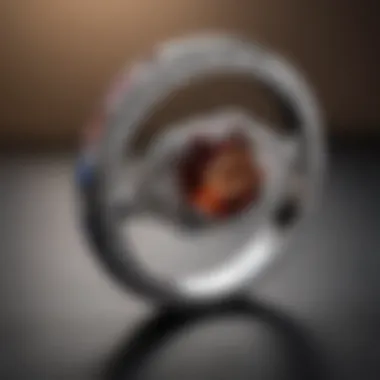
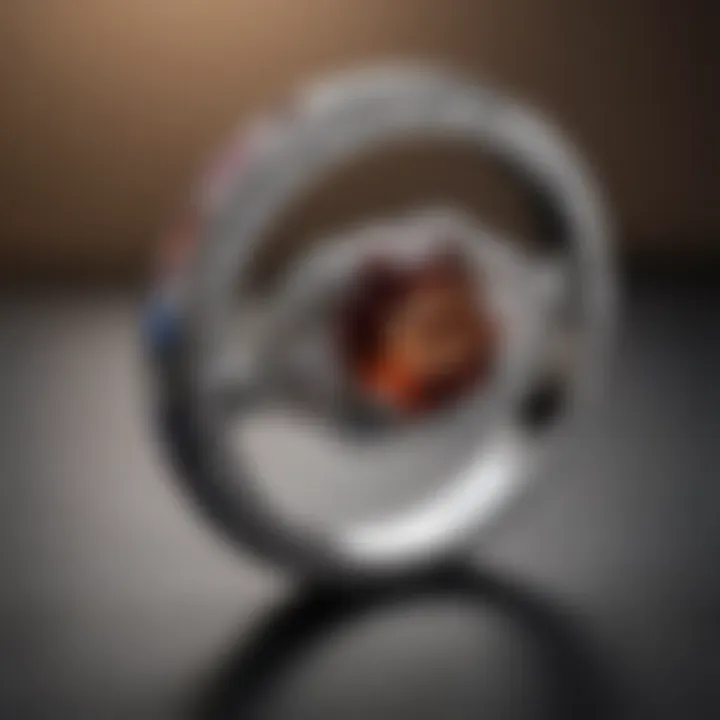
- Does the engagement ring complement other pieces?
- How do different metals or stones interact visually?
- What message do the combined pieces convey about your personality or relationships?
The decision does stretch beyond glamour; each piece of jewelry can hold memories, milestones, or emotions. Thus, the choice of placement offers a unique chance to reflect one’s journey, solidifying the engagement ring’s importance in broader contexts.
The Role of Personal Preference
Personal preference plays a crucial role in the selection and placement of engagement rings. This importance goes beyond mere aesthetics; it encompasses values, identity, and even emotional resonance. In an age where personalization is prized, understanding the impact of individual choice in ring selection allows couples to express their unique bond through meaningful symbols.
Selecting an engagement ring can feel like navigating a labyrinth. The choice extends into various realms—style, material, and even the specific hand on which the ring is worn. Each element is a reflection of the wearer’s personality and tastes. For instance, some might gravitate towards a classic diamond solitaire, while others opt** for colored gemstones that speak to their personal story or heritage. This individuality in ring selection provides not only an opportunity for self-expression but also a chance for couples to forge a deeper emotional connection.
A few considerations when assessing personal preference include:
- Cultural Background: Many people draw from their ancestry, which may influence color choice or even design.
- Lifestyle Needs: An active lifestyle might steer one toward a sturdier band or low-profile settings.
- Personal Style: Rings that align with one's everyday aesthetic draw more satisfaction and wearability.
"The engagement ring is not just a piece of jewelry; it’s a chapter in a personal love story, crafted by the choices of those involved."
Individuality in Ring Selection
Individuality shines brightly in the realm of engagement ring selection. Each choice—be it a vintage design or a modern twist—reveals a layer of a person’s character. For those who favor uniqueness, the rise in custom jewelry provides a canvas for creativity. The actual symbolism associated with a ring often communicates the wearer's values and aspirations.
When exploring individuality, keep in mind that the world of gemstones offers an array of options beyond the traditional diamond. Gems like sapphires or emeralds can tell stories not just through their colors but also through their origins. Moreover, the cut of the stone plays a role; whether it’s a brilliant cut or perhaps an unconventional shape, it speaks volumes about personal tastes.
For some, the ring's settings—like vintage or minimalist—can echo personal sentiment or nostalgic connections that perhaps relate to family heirlooms or childhood dreams. Ultimately, a uniquely personal ring can often evoke affirmative sentiments that add depth to the engagement experience.
Consulting with Partners
Consulting with partners during the ring selection process embodies respect, love, and partnership. It fosters an atmosphere of collaboration rather than unilateral decision-making. While many might envision a surprise proposal, openly discussing preferences beforehand may yield a more meaningful result.
A practical approach to consulting can include:
- Open Conversations: Discussing what each partner envisions for their ring establishes transparency.
- Try-on Sessions: Visiting jewelry stores together can serve as a delightful way to gauge preferences and styles.
- Exploring Symbolism: Engaging in dialogue about what each component means personally can enrich understanding.
Moreover, consulting with one's partner also signifies the importance of mutual respect in decision-making. Both individuals should feel empowered to express their desires and hesitations without the fear of judgment. More than just selecting a ring, it is an experience that solidifies the relationship’s foundation.
In essence, personal preferences in engagement ring placement not only mirror individuality but also strengthen bonds through shared decisions. This nuanced engagement cultivates an atmosphere of trust and excitement as couples embark on a lifelong journey together.
Influence of Local Customs
Understanding the influence of local customs on engagement ring placement is crucial. It not only defines how individuals express their commitment but also highlights the diverse ways cultures approach love and marriage. Local customs serve as a marker of identity, embodying the cherished beliefs and practices of different communities.
Regional Variations in Ring Placement
When we consider regional variations in ring placement, it becomes evident that there is no "one size fits all" approach. For example, in Western cultures, it is common for engagement rings to be worn on the fourth finger of the left hand, attributed to the long-held belief that this finger contains a vein that directly connects to the heart. Conversely, in some Eastern cultures, the right hand may carry more significance, with the ring often placed there instead. This practice can stem from traditions associated with auspicious settings and future prospects in life.
Additionally, in France, an engagement ring is typically worn on the right hand during the engagement period but switched to the left hand for marriage. Meanwhile, in places like India, the concept of engagement rings may not be as prevalent. Here, the traditions greatly favor more elaborate ceremonial practices with the use of bangles or necklaces, which carry symbolic weight, often surpassing the standard engagement ring.
"The placement of an engagement ring is a deed of love, but how and where it is worn can speak volumes about the cultural backdrop that shapes it."
Impact of Modern Law and Society
Modern law and societal shifts have also molded how engagement rings are perceived and placed. In some countries, marriage laws may dictate or influence the wearing of rings. For instance, in Sweden and Norway, there is a formal legal framework that recognizes and aligns marriage principles with the use of rings. Thus, there exists a structured guideline on when and how engagement rings should be worn.
Furthermore, societal changes, particularly in the context of rising egalitarian views, have prompted couples to rethink traditional norms. The idea of who proposes and who wears an engagement ring is evolving. Many men now also wear engagement rings, blurring gender lines and permitting partners to express their commitment. Society has gradually accepted that personal choice triumphs over historical customs.
The Material and Design of the Ring
Engagement rings are much more than just decorative items; they embody deep-seated emotions and shared promises between partners. Their material and design play pivotal roles in conveying personal values, cultural significance, and enduring beauty. When considering the placement of engagement rings, it’s essential to explore the aspects of material and design to truly grasp their implications in relationships and traditions.
Gemstone Selection
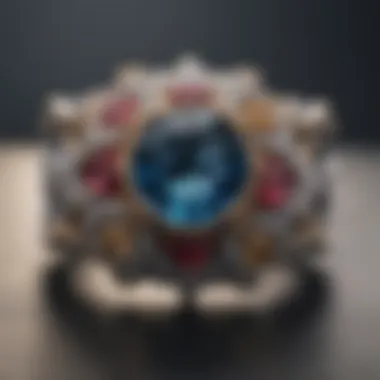
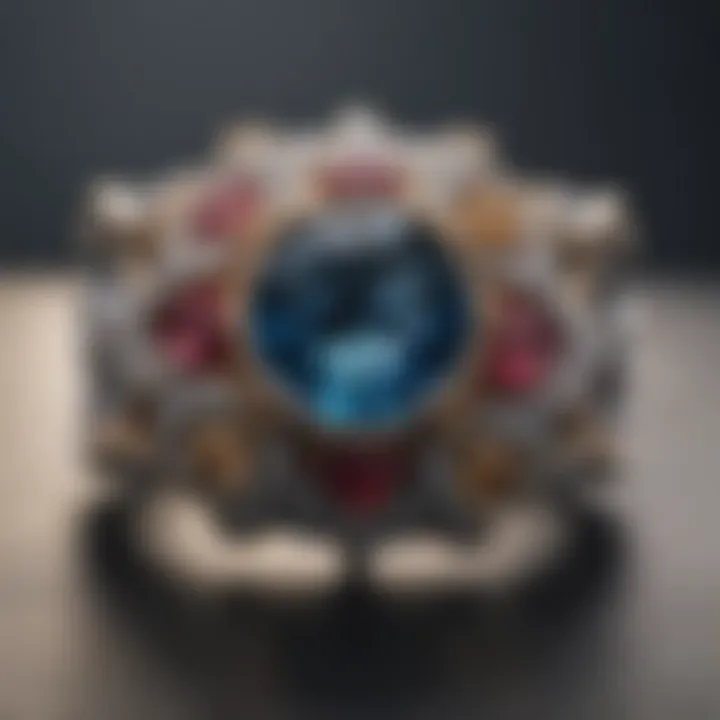
The choice of gemstone is a cornerstone in the conception of an engagement ring. Different stones carry distinct meanings and personal attributes. For instance, diamonds have long been seen as symbols of eternal love, owing to their durability and brilliance, but they may not resonate with everyone’s ideals. Some couples might opt for sapphires for their deep hues or emeralds, which signify rebirth and hope.
When selecting a gemstone, individuals often face a few considerations:
- Personal Preference: Some might prefer the classic appeal of diamonds, while others may gravitate towards colorful alternatives.
- Cultural Influence: In some cultures, specific gems are preferred due to their historical significance or believed powers. For example, in certain traditions, rubies are favored for their associations with passion and protection.
- Sustainability Concerns: As awareness around ethical sourcing grows, many couples now seek lab-created or responsibly sourced stones. This aligns their values with their choice of engagement ring.
Ultimately, the gemstone should reflect both the personality of the wearer and the couple's collective journey. Selecting the right stone can narrate the story of their relationship.
Ring Style and Placement
The style of an engagement ring must harmonize with not only the chosen gemstone but also the intent behind its giving. Traditional styles, such as solitaire settings, often symbolize simplicity and clarity. In contrast, more intricate designs like halo settings can convey extravagance and fervor.
Placement also touches on personal and cultural facets. For example:
- Traditional Placement: In many Western cultures, rings are placed on the fourth finger of the left hand, which is thought to directly connect to the heart. However, in some Eastern cultures, the same ring can find its home on the right hand, symbolizing a different set of traditions and meanings.
- Innovative Designs: Some couples choose to express their uniqueness by going for non-traditional placements or styles. This could mean a ring stacking approach or even unconventional finger placements, challenging established norms and embracing individual flair.
"The design and placement of an engagement ring can often tell more about a couple than the ring’s material ever could."
Significance of Ring Placement in Relationships
Engagement rings often carry deeper meanings beyond their gleam and luster. They symbolize commitment, love, and shared futures. Yet, the significance of their placement is paramount in shaping how individuals and couples perceive their relationship dynamics. The choice of finger, from the left to the right hand, or even a preference for a different finger altogether, can speak volumes about personal traditions, cultural customs, and individual interpretations of love.
Cultural Expectations
Cultural norms dictate a lot about how engagement rings are viewed and worn. In the Western world, for instance, it's customary for the engagement ring to be worn on the left hand. This tradition roots back to the notion that the left hand features a vein, often referred to as the "vena amoris," which is believed to connect directly to the heart. This makes wearing an engagement ring on this finger a powerful symbol of love and intent.
Across the globe, different cultures have varied expectations regarding the placement of rings. In some Eastern traditions, the right hand is preferred, symbolizing the public commitment the couple is making. In contrast, the left hand might be reserved for daily wear or providing more personal meaning. This selection can lead to misunderstandings if one partner is unfamiliar with the other's customs.
- Regional Differences:
- In India and many Middle Eastern cultures, wearing the engagement ring on the right hand illustrates a connection to societal and familial expectations.
- In Scandinavian countries, the choice of hand is less significant; both hands can serve to convey the bond of engagement.
"The placement of the engagement ring is not merely a choice; it’s a reflection of shared values and cultural heritage that accompany the journey of love."
Reflections of Commitment
The choice of where to place an engagement ring often mirrors the commitment level within the relationship. Couples may opt for traditional placements to signify adherence to customs and values that enhance their bond. Others may choose placements that are less conventional, showing a desire to express individuality or a modern approach to romance.
This choice is also laden with interpretations. For instance, wearing an engagement ring on the right hand could signify a more egalitarian partnership, where both parties have a voice in the relationship, contrasting with traditional views that sometimes place emphasis on one partner’s expectations.
- Attributes of Commitment in Ring Placement:
- It highlights the couple’s intention to navigate societal norms while asserting their individuality.
- The ring's placement has potential implications for how their relationship is perceived by third parties, signaling openness or traditionalism.
At the end of the day, the significance of placement in a relationship is nuanced. It intertwines communal expectations with personalized nuances, making ever ring a centerpiece not just of romance, but of identity and culture.
Culmination: Beyond the Ring
Understanding the placement of engagement rings transcends mere aesthetics or tradition; it encompasses a deep cultural significance and personal connection. Exploring this topic sheds light on how different societies view commitment and love, helping to enrich our understanding of relationships today.
Personal Meaning in Engagement
The sentiment behind an engagement ring is as varied as the individuals who wear them. For some, it represents a promise—a tangible manifestation of love and a pledge for the future. It embodies personal stories, unique journeys, and shared ambitions. As couples select a ring, the meanings imbued often reflect their history together. From the choice of design to the exact placement, each decision carries weight.
In various cultures, the placement signifies more than just marital status; it resonates with deeply held beliefs about love and compatibility. For example, many Western traditions place the ring on the left hand, associating it with the heart. In contrast, in other cultures, different hands are emphasized, each carrying its own unique symbolism. As such, it’s essential to grasp these nuances to appreciate what the ring signifies to each person.
Investing time to discuss what the ring means can deepen emotional connections. Considerations like shared values and mutual aspirations can bring about richer dialogues that solidify partnerships and commitments. The ring, thus, becomes a shared emblem of understanding and trust.
The Future of Engagement Ring Traditions
As the world evolves, so too does the notion of engagement rings. Traditional practices are adjusted, and new trends emerge, often blending old customs with innovative ideas. For instance, sustainability has become a leading factor in ring selection, with many couples choosing ethically sourced or lab-grown gemstones. This choice reflects a broader societal shift towards responsibility and awareness.
In addition, personalized designs are gaining traction. Rather than standard styles, many couples are opting for rings that resonate with their individual stories or shared experiences. The rising popularity of custom designs stands as testament to the fact that engagement rings are becoming more than just a piece of jewelry; they are uniquely crafted memories.
Looking into the future, we might also see a more inclusive approach towards engagement rings. Diverse relationship structures and preferences are prompting conversations about engagement traditions that suit all types of relationships.
"The evolution of engagement rings mirrors societal changes, as couples redefine what commitment looks like for them."
In wrapping up, engagement ring practices encapsulate both rich traditions and evolving narratives. And as we delve deeper into the significance behind these rings, we unveil an intricate tapestry of meaning woven through cultural expectations and personal choices. The debate surrounding the best practices may always be up for discussion, but what remains constant is the spirit of connection that these rings symbolize.



